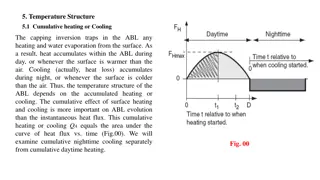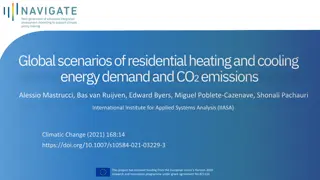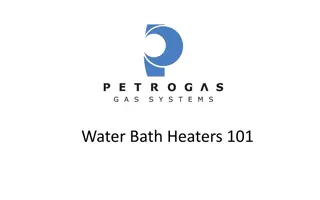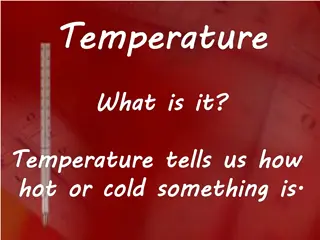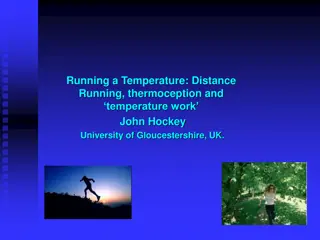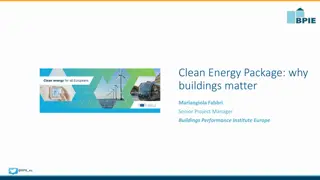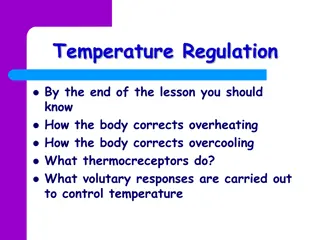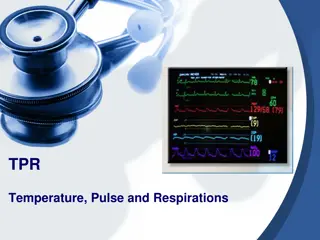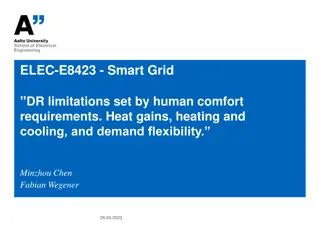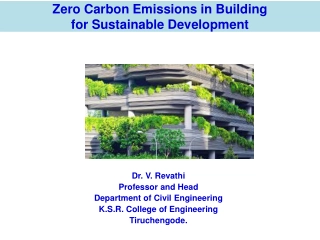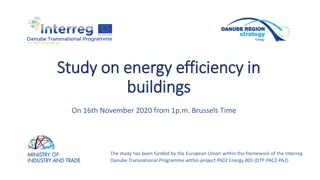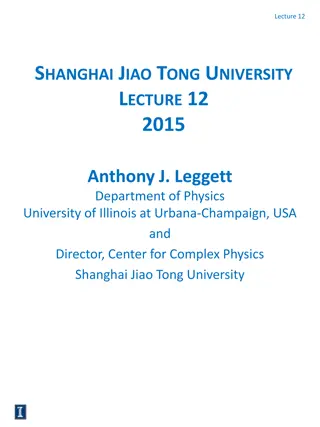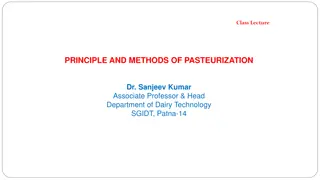Implementation Guide for Low-Temperature District Heating in Existing Buildings
Explore the journey towards implementing Low-Temperature District Heating (LTDH) in existing buildings and installations. Discover the motivation, goals, and the evolution of district heating generations from steam-based systems to the innovative 4th generation. Gain insights into financial aspects, energy supply systems, pilot projects, and best practices for LTDH projects. Learn about the benefits of LTDH such as lower heat losses, integration of renewable heat sources, and compatibility with cooling networks and smart energy systems.
Download Presentation

Please find below an Image/Link to download the presentation.
The content on the website is provided AS IS for your information and personal use only. It may not be sold, licensed, or shared on other websites without obtaining consent from the author. Download presentation by click this link. If you encounter any issues during the download, it is possible that the publisher has removed the file from their server.
E N D
Presentation Transcript
Best Practice No. 1 Implementation of LTDH in existing buildings and installations
LowTEMP training package - OVERVIEW Power-2-Heat and Power-2-X Introduction Financial Aspects Thermal, Solar Ice and PCM Storages Intro Climate Protection Policy and Goals Life cycle costs of LTDH projects Heat Pump Systems Intro Energy Supply Systems and LTDH Economic efficiency and funding gaps LT and Floor heating Energy Supply Systems in Baltic Sea Region Contracting and payment models Tap water production Business models and innovative funding structures Energy Strategies and Pilot Projects Ventilation Systems Methodology of Development of Energy Strategies Technical Aspects Best Practice Pilot Energy Strategies Aims and Conditions Pipe Systems Best Practice I Combined heat and power (CHP) Best Practice II Pilot Energy Strategy Examples Large Scale Solar Thermal Pilot Testing Measures Waste & Surplus Heat CO2 emission calculation Large Scale Heat Pumps LCA calculation 2
Motivation and Goal On the road to LTDH The main motivation and goal is to present various possible roads to lowtemperature(4Gen) district heating implementations Here we concentrate on issue of possible LTDH implementation in an existing city districts (after building renovation and without it) and a whole city 3
What is 4th Generation District Heating (DH)? 1stGen DH - steam-based system fuelled by coal; first introduced in the US in the 1880s; became popular in some EU countries,too. 2ndGen DH (1930 1970) supplywater temperature above 100 C and coal as main energysource 3rdGen DH (most popular now) lower supply temperature (80 100 C); use coal, biomass and wastes as primary energysources; 4thGen DH knocking at the door (with pilot installations in Denmark, England, Norway, Belgium, Finland, and Germany) supplytemperature below 70 C (LTDH) enables lower heat losses, integration of renewable heat (solar,geothermal, wastes and biomasssources) compatibilitywith coolingnetworks and smart energysystems. 5thGen DH being discussed; integrates heating and cooling, enables demand side response and related thermal energystorage, and wider integrationof waste/surplus heat sources.(e.g.Ectogrid E.ONSverigeAB) 4
LowTemperature District Heating (4G LT DH) From 1 generation (above 100 C) to 4 generation (below 60 C) districtheating After Guidelines for Low-Temperature District Heating Source: http://www.danskfjernvarme.dk/~/media/danskfjernvarme/gronenergi/projekter/eudp- lavtemperatur%20fjv/guidelines%20for%20ltdh-final_rev1.pdf
Roadmap to Low Temperature DH e) Lowtemperaturewaste heatsourceto heatpump source heat T = 20 C Heatpump After Guidelines for Low-Temperature District Heating Source: http://www.danskfjernvarme.dk/~/media/danskfjernvarme/gronenergi/projekter/eudp- lavtemperatur%20fjv/guidelines%20for%20ltdh-final_rev1.pdf f) Loweringtemperatur in wholeDH
Content IMPLEMENTATION IN RENOVATEDBUILDIGS Energy efficient renovation of buildings and implementation of LTDH, Albertslund (DK) Conversion of a school into a passive house, Max-Steenbeck-Gymnasium (GER) Comprehensive thermomodernization and implementation of LT heating system, Jablo (PL) IMPLEMENTATION IN unRENOVATED BUILDIGS Pilot LTDH system in existing detached houses, S nderby (H je-Taastrup, DK) IMPLEMENTATION IN A WHOLE CITY How to change the existing district heating network into LTDH grid implementation of pilot project in om a (PL) 7
Testing LTDH in renovated buildings Name Surname, Title, Organistation Name of Event etc. 8
1. Albertslund, Denmark Energy efficient renovation of buildings and implementation of LTDH Name Surname, Title, Organistation Name of Event etc. 9
Project profile Energy efficient renovation Implementation LTDH Topic Year of construction 2015 Albertslund Project leader Albertslund Kommune 10
Albertslund, Denmark Project background Albertslund is known as living-lab for new eco-solutions, including energy and finance saving heating system Heat is provided from 4 sources of Copenhagen metropolitan district heating system (in Albertslund network area there is only one peak load boilers of few hundred kW power and no CHP system). In Copenhagen metropolitan area there are located: waste combusting boiler and CHP plant (393 MW), multi-fuel CHP plant (2651 MW, heat output from biomass of approx. 1500 MW), reserve/peak boiler; thermal storage capacity is 3000 MWh without the storage being built in H je Taarstrup Goal By 2025 all heat and energy will be produced without CO2emission by introduction of 4th generation DH and better use of local energy sources (wind farms and heat pumps) Source: Albertslund Kommune, Housing department, Denmark 11
Albertslund, Denmark Pilot project takes place in part of Albertslund: old and poor housing district 560 houses, built from 60 s to 70 s finished in 2015 largest LTDH system in Denmark pilot project Source: Albertslund Kommune, Housing department, Denmark 12
Albertslund, Denmark Pilot project: Approach comprehensive refurbishment, which included: roof, wall and basement insulation, materials with a factor of = 0.020 W/(m*K) were used floor heating system with additional new radiator (two or three layer LT radiators) with blowers the supply temperature of the LTDH city system is 57 C, e.i. at the inlet to the heat exchanger of every house Source: Albertslund Kommune, Housing department, Denmark 13
Albertslund, Denmark Pilot project: Results embellished appearance of the quarter through refurbishment heat use and costs have decreased by 50% poor citizens can cover the renovation costs by saving on energy bills Source: Albertslund Kommune, Housing department, Denmark 14
2. Max-Steenbeck-Gymnasium, Germany Conversion of a school into a passive house Name Surname, Title, Organistation Name of Event etc. 15
Project profile Reconstruction of school into passive house Topic Year of construction 2010 - 2012 Project leader City of Cottbus Cottbus 16
Max-Steenbeck-Gymnasium, Germany Project background school was built in 1974 from prefabricated concrete slabs Goal conversion into passive house with best economic efficiency and consideration of operational costs for 30 years Source: Kr ger Ingenieure opening decision planning reconstruction monitoring optimization 2008 2009 2010 2011 2012 2013 2014 2015 2016 17
Max-Steenbeck-Gymnasium, Germany Pilot project: Approach use of ground heat storage (injection of heat from solar collectors) geothermal energy for winter and summer use (pre-heating and pre-cooling of the ventilation system) heating by use of the return flow from the radiators Source: Jan Gerbitz, ZEBAU, Germany 18
Max-Steenbeck-Gymnasium, Germany Pilot project: Results Benefits of return flow reconstruction costs EUR 12.8 million lower return flow temperature building construction 460 EUR/m lower heat loss on the way back to the heating plant building services (including tax) 254 EUR/m less than 34 kWh/m annually for heating and mechanical ventilation higher efficiency of heat transfer in the heating plant about 55% of heat energy from return flow sustainable technology for low temperature heat sources only 17% of heat consumption from DH after reconstruction 19
3. Jabo, Poland LT local heating system as an element of comprehensive thermomodernization of buildings Name Surname, Title, Organistation Name of Event etc. 20
Project profile Comprehensive thermomodernization and implementation of LT heating system Topic Year of construction 2020 Jab o Project leader Municipality of Jab o Housing Communities 21
Jabo, Poland Project background Agricultural rural region Part of the Jab o village is under protection of the heritage conservator (including the park and palace complex -the former seat of the Zamoyski family) building renovations had totake into account requirements of the conservator. Since 2006 solar PV modules have been installed at about 350 private and public buildings. Goal Improvement of energy efficiency in multi-family residential buildings of the commune through comprehensive thermomodernization using low-temperature energy sources. Project "Renewable energy sources in the Municipality of Jab o " was co-financed from EU funds. Sources: Municipality of Jab o , Narodowy Instytut Dziedzictwa, Jacek Halicki, pl.wikipedia.org 22
Jabo, Poland Project object General characteristics - state before modernization multi-family residential buildings - terraced houses 1 Type of buildings 1990 2 Construction year traditional - brick buildings (aerated concrete) 3 Building technology [m3] Total building volume 4 8 000 [m3] Total volume of the heated part 5 3 540 [m2] Total usable area 6 1 733 [m2] Total area of the heated part 7 1 460 Number of terraced segments 8 4 Number of floors 9 2 + attic (partially usable) 10 Total number of inhabitants [persons] 52 Total number of apartments 11 [pcs.] 22 Source: Teresa Zurek, IMP Gdansk 23
Jabo, Poland Project object Heating system - state before modernization 1 Heat source Coal boiler room (space heating + domestic hot water). HEITZ MAX EKO 150 boiler with a power of 60-150 kW. Year of assembly - 2010. Operated only during the heating season. 2 Preparation of domestic hot water 1) Central preparation for 17 residential premises Only during the heating season. Storage heaters (2x750 l) supplied from the boiler room. 2) Individual preparation 17 apartments - only summer period. 5 apartments - all year round. Electric heaters. Source: Teresa Zurek, IMP Gdansk 24
Improving the thermal insulation Jab o , Poland Basic assumptions of the project Heat transfer coefficient 1. Insulation of building partitions U = 0,20 U = 0,19 0,22 U = 0,25 U = 0,14 U = 0,20 0,22 1. Exterior walls of basements 2. External walls of overground storeys 3. Floor above the unheated basement 4. Ceilings under the unused attic 5. Internal walls between heated and unheated rooms (basement and attic) 2. Installation of new windows and doors of building partitions U = 0,90 U = 0,90 / 1,30 U = 1,30 1. Windows in residential premises 2. Windows and external doors in common areas 3. Interior doors in partitions separating heated and unheated rooms 3. Additional improvements New moisture insulation basement walls in contact with the ground Source: Foto -Teresa Zurek, IMP Gdansk 25
Jabo, Poland Heat pumps and buffer tank installed in the building Basic assumptions of the project Photovoltaic installation in the south-eastern part of the building 1. Modernization of the building's thermal energy supply system Modernization of the heating system 1. Liquidation of the existing coal-fired boiler room 2. The use of low-temperature heat sources designed to work for the needs of heating and hot water preparation (2 heat pumps with a thermal power of 42.8 kW each) 3. Installation of photovoltaic cells for electricity production for own needs (electricity supply to heat pumps) 66 pcs of PV panels x 300 W - total power 19.8 kW. 4. Installation of an energy management system in the building. 2. Modernization of the central heating installation Replacement of the entire central heating installation in building segments for a new one (a low temperature installation - heating water parameters 55 / 45oC). 3. Modernization of the hot water supply system 1. Liquidation of individual sources of domestic hot water preparation 2. Coverage of all apartments with central year-round hot water supply 3. Modernization of the existing hot water installation in the buildings (thermostatic valves on hot water circulation, new thermal insulation of pipelines). Source: Foto -Teresa Zurek, IMP Gdansk 26
Jabo, Poland Pilot project: Expected results Effects (decrease) [%] Before After No. Name Unit modernization modernization 1 Usable energy demand GJ/year MWh/year GJ/year MWh/year MWh/year 811 225,2 1 520 422,3 496,7 432 120,1 161 44,7 61,7 Energy and ecological effects 47 2 Final energy demand 89 496,7 [MWh/year] 3 Primary energy demand 88 422,3 500,0 4 Unit indicators a) usable energy 400,0 kWh/(m2 year) kWh/(m2 year) kWh/(m2 year) tons of CO2 /year 154 82 47 b) final energy 289 31 89 225,2 300,0 c) primary energy 340 42 88 200,0 120,1 5 CO2 emissions 154 19 88 61,7 44,7 100,0 6 Electricity production in the PV installation 20 MWh/year Covering the demand for electricity for heat pumps by a PV system 0,0 7 45 % Usable energy Final energy Primary energy Before modernization After modernization Share of RES in covering the demand for heat 8 83 % 27
Jabo, Poland Pilot project: Expected results Financial characteristics Economic effects No. Name Units Value Effects (decrease or increase) [%] Before After Name No. Unit 1 Total investment costs z 1 615 000 modernization modernization 354 945 decrease 1 Energy costs (heating + hot water) / year 15 378 3 719 76 z / m2 / m2 932 Unit investment costs per 1 m2 of usable floor space of the buildings 2 increase 2 Unit costs of heat energy / GJ 10,11 23,12 129 205 / m2 decrease 10,53 2,55 76 3 Simple period back time SPBT a) including the full investment costs years 30,4 15 378 23,12 10,53 [ / GJ] [ / year] [ / m2] b) after taking into account EU funding years 4,6 16 000 25,00 12,00 20,00 12 000 10,11 8,00 15,00 2,55 3 719 8 000 10,00 85% funding obtained 4,00 4 000 5,00 0,00 0,00 0 Before modernization After modernization Before modernization After modernization Before modernization After modernization Unit heat costs per 1 m2of heated area Total annual heat costs Unit heat costs of 1 GJ of heat 28
Jabo, Poland Conclusions 1. The efficiency and economy effects of the heat suply by low-temperature heat pumps depends a lot on the amount of electricity produced on site (PV modules). 2. In the considered case, necessity to take into account the requirements of conservator, excluded the installation of PV panels on the roof surface from the side of the historic palace and park complex. This resulted in a limited number of PV panels and reduced production of own electricity (covering only 45% of the heat pumps' demand). This has an impact on the unit costs of 1 GJ of heat energy, which increased if comparedto the state before modernization. 3. Theincrease in unit costs of 1GJof thermal energy is compensatedby very large savings of the finalenergy used in the buildings (decrease in consumption by 89%), which means that the total costs of heating and domestichot water preparation are 76% lower than before the modernization. 4. The project is therefore characterized by very large economic benefits for residents resulting from significantlyreducedfees that willbe incurredfor heating and hot water preparation. 29
Testing LTDH in unrenovated buildings Name Surname, Title, Organistation Name of Event etc. 30
4. Snderby, Denmark Pilot LTDH system in existing detached houses Name Surname, Title, Organistation Name of Event etc. 31
Project profile Pilot LTDH system for detached houses Topic S nderby H je-Taastrup Year of construction 2013 H je-Taastrup Fjernvarme a.m.b.a. Project leader 32
Snderby, Denmark Project background H je-Taastrup municipality is a suburb of Copenhagen known for its green transformation agenda municipality consists of small residential areas, with family houses, row houses and some multifamily houses, most build in 60 s to 80 s Goal 100% carbon free region by 2050 Source: OpenStreetMap contributors 33
Snderby, Denmark Pilot project development of a pilot LTDH system in 75 existing detached houses total heated area of 11,230 m2 old distribution pipelines pair of plastic single pipes account for heat losses of about 38- 44% of the heat delivered from the central heat exchanger Source: H je-Taastrup Fjernvarme a.m.b.a., Denmark 34
Snderby, Denmark Pilot project: Approach under-floor heating and return water flow from the neighbour area as the main supply ( cold supply ) for the system new pipe system: TwinPipe system, series 2, size 76 and smaller with Logstors alarm-system X4 ensures accurate identification of the failure location return water temperature can be mixed with a portion of hot water from the normal hot water utility supply if it is not sufficient for LTDH- network heat conductivity factor = 0.022 W/(m*K) Installation of new substations in each house, an instantaneous water heater type, designed for a capacity of 32.3 kW The cold supply provides heat in the range of 30-67 C (average 48 C) The hot supply provides heat in the range of 65-107 C (average 80 C) 35
Snderby, Denmark Pilot project: Results heat losses decreased to 13% measured supply and return temperature of LTDH network was 55 C and 40 C (design values 55 C and 27-30 C) at consumer substations, the temperatures were ~53 C and 38 C (design values 50 C and 25 C) LTDH is sensitive to consumer habits, e.g. large consumptions The application of LTDH is possible in existing housing areas Source: H je-Taastrup Fjernvarme a.m.b.a., Denmark 36
Implementation of LTDH in the whole city Name Surname, Title, Organistation Name of Event etc. 37
5. How to change the existing district heating network into LTDH grid implementation of pilot project in om a (PL) Application of verified computer simulations method related to conversion the existing DHs into LTDHs, (ExToLTDHSmd) Name Surname, Title, Organistation Name of Event etc. 38
Project profile Conversion of the whole existing DH into LTDH Topic Year of construction 2017 - 2022 om a Mieczys aw Dzierzgowski WUT, IMP PAN Project leader 39
oma, Poland Project background om a is situated in the North East Region of Poland, 63 000 inhabitants, 32.7 km2 Goal By 2022 : to convert the whole existingDH in to LTDH From 121/65 C in 2017 to 89 / 48 C in 2022 Decreased heat production from coal from 100% in 2017 to 11.6% in 2022 Source:kamil-brzostowski 40
oma, Poland Pilot Project 2017/2018 : On the road from existingDH.to LTDH Nominal supply and return temperatures:Ts/Tr = 121 C / 65 C Nominal heat demand of the existing coal-fired heat plant with boilers 98.52 MWt. Verified heat demand: 73.71 MWt 860substations, 160 km length of theDH grid Actual heat losses of DHgrid: - 12.5% Primary energy source 100% coal. In 2017/2018 Seasonal Heat Production: 484 300 GJ, 100%from coal Source: Mieczys aw Dzierzgowski: Strategy for implementationthe LTDHS in Existing DHS in OM A, Raport 1, 2018 41
oma, Poland Project step 1 2017/2018 datacollection modelingof existingDH and verification ofDH model analysesand elimination offailuresand operation errors in the substations Actual results Regulation of existing substations to comply with requirements of energy efficientLTDH Results: decreased(required) mass flow 55% ; increased temperature drop 43.2% Differences between Calculated an Actual Operational Parameters below 3.0% Source: Mieczys aw Dzierzgowski: Strategy for implementation the LTDHS in Existing DHS in OM A, Raport 2, 2018 42
oma, Poland Project step 1 2017/2018 Substation 1 Measured and calculated hourly changes of the heat demand, mass flow, supply and return temperatures, % opening of the control valve before and after HEs cleaning Substation 1 Schematic Layout Source: Mieczys aw Dzierzgowski: Strategy for implementation the LTDHS in Existing DHS in OM A, Raport 2, 2018 43
oma, Poland Project step 2 2017/2018 computer simulations of the whole existing DH grid with the New Individual Quantity/Quality Regulations Time evolution of supply and return temperatures, flow rate and heat demand in 2017/2018 season Source: Mieczys aw Dzierzgowski: Strategy for implementation the LTDHS in Existing DHS in OM A, Raport 3, 2018 44
oma, Poland Project step 2 2017/2018 Actual results Decrease Nominal Supply Temperature from 121.5 to 109.8 C decrease of seasonalDHheat losses from 12.6 to 10.6% Average seasonal DH return temperature: Tr = 45.1 C Comparison between measured and calculated values of heat demand, mass flow and return temperature during heating season 2017/2018 differences < 3% Measured and calculated supply and return temperatures, flow rate and heat demand of the whole DH grid - heating season 2017/2018 Source: Mieczys aw Dzierzgowski: Strategy for implementation the LTDHS in Existing DHS in OM A, Raport 3, 2018 45
oma, Poland Project step 3 2019/2020 New Biomass-fuelledboiler in existing coal-fired heat plant Implementation of new biomass-fueled boiler and new gas-fired heat plant New biomass-fuelled boiler 15 MW was installed in the beginning of 2020 New gas-fired heat plant implemented 2020. (In the remote region of existing DH grid with mostly old, refurbished buildings, year of construction from 60 s to 80 s) New gas-fired heating plant New BIOMAS COGENERATION UNIT 14.0 MWt of heat and 2.8 MWe of power is planned to be installed in 2022. Layout of existing DH grid in om a - supplied from existing heating plant and new gas-fired heating plant (in yellow) Goal : In 2020/2021Seasonal Heat Production: 52.0% Biomas, 36.4%Gas, 11.6% Coal Source: Mieczys aw Dzierzgowski: Strategy for implementation the LTDHS in Existing DHS in OM A, Report 4, 2020 46
oma, Poland Project step 4 2019/2020 computer simulations optimization of seasonal regulation conditions of the new biomass boiler new gas-fired heat plant and common open DH network Preasure changes along network from coal/biomas fuelledboiler to gas-fired heat plant Source: Mieczys aw Dzierzgowski: Strategy for implementation the LTDHS in Existing DHS in OM A, Raport 4, 2020 DH Layout 47
oma, Poland Actual results Decreased nominal supply temperature in gas-fired heat plant and existing DH subsystem (17.5 MW ) from 109.8to 96.3 C (LTDH) Change of primary energy source reduction of coal from 100.0% to 11.6% Calculated hourly changes of supply temperature, flow rate and heat load of gas, biomass andcoal-firedboilersunder2019/2020heatingseason conditions. Primary energy sources during 2020/2021 season Source: Mieczys aw Dzierzgowski: Strategy for implementation the LTDHS in Existing DHS in OM A, Raport 4, 2020 48
oma, Poland Goal by 2022 Heat and energy will be produced with 75% reduction ofCO2 emission TransformationofthewholeexistingDH intoLTDH Decrease of DH heat losses from 12.6% to 9.5% (use of biomass - local energy source in boilers and CHP unit) Source: Mieczys aw Dzierzgowski: Strategy for implementation the LTDHS in Existing DHS in OM A, Raport 4, 2020 49
Conclusions The verified model characteristics of the often oversized heat exchangers and radiators enables implementation of the New individually profiled quantity/ quality seasonal regulation as well as transformation of DH into effective LTDHgrids in allBSRcountries before 2030. of the existing DH network in om a based on thermal and hydraulic Guidelines and demonstration of how the WHOLE existing DH System should be prepared and transform tothe LTDHare available butshouldbe developed further. LTDH networks are very sensitive to characteristics and technical state-of-art of consumers space- heating installations (e.g. Proper individually profiled heating curve , technical state of the heat exchangerstheir oversizingas wellas qualityandoperationalconditionsofthe controlsystem) Transformation of the existing DH to LTDH grids is possible; leading to 15 - 25% reduction of the heat lossesandemissions.Theaimcanbe achievedafter goodverified pilot-project. 50




